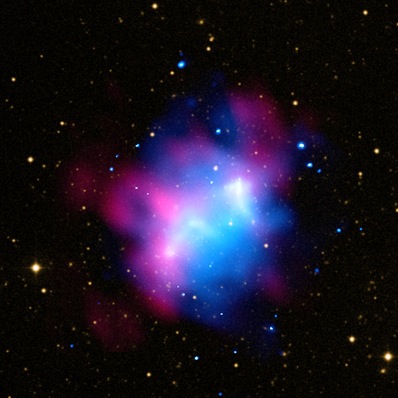
Colliding clusters turn on radio halos
DR EMILY BALDWIN
ASTRONOMY NOW
Posted: 01 September 2010


A study of 32 galaxy clusters using the Chandra Space Observatory and the Giant Metrewave Radio Telescope (GMRT) shows that collisions between clusters trigger huge radio halos.

Composite image from Chandra (blue, X-ray data) and the Giant Metrewave Radio Telescope (pink, radio data) showing the effect of a collision between two galaxy clusters. Image: X-ray (NASA/CXC/SAO/M.Markevitch); Radio (TIFR/GMRTSAO/INAF/R.Cassano, S.Giacintucci); Optical (DSS).
The new image shows a 12 million light year wide galaxy cluster known as Abell 1758, located 3.2 billion light years away in the constellation Canes Venatici. Clusters are groups of galaxies bound together by gravity, with swathes of hot gas permeating the intracluster medium. They are some of the largest structures in the Universe, with clumps of mysterious dark matter likely contributing to their gravitational strength.
Collisions between clusters generate huge of amounts of energy, and in this image the rich pink and blue hues represent radio and X-ray data respectively. While the X-ray data is indicative of hot gas, the GMRT data reveals radio halos generated by relativistic particles and intense magnetic fields.
The observations of Abell 1758, along with 31 other clusters in the study, show that galaxy clusters with radio halos are still forming, while clusters without clear radio emission are not still accumulating large quantities of material. The result also implies that electrons moving at close to the speed of light are likely accelerated by turbulence stirred up by the merging event.
The rate at which clusters are forming has slowly decreased over the last seven billion years due to the effects of dark energy, a force used to explain the acceleration of the expanding Universe.
|



